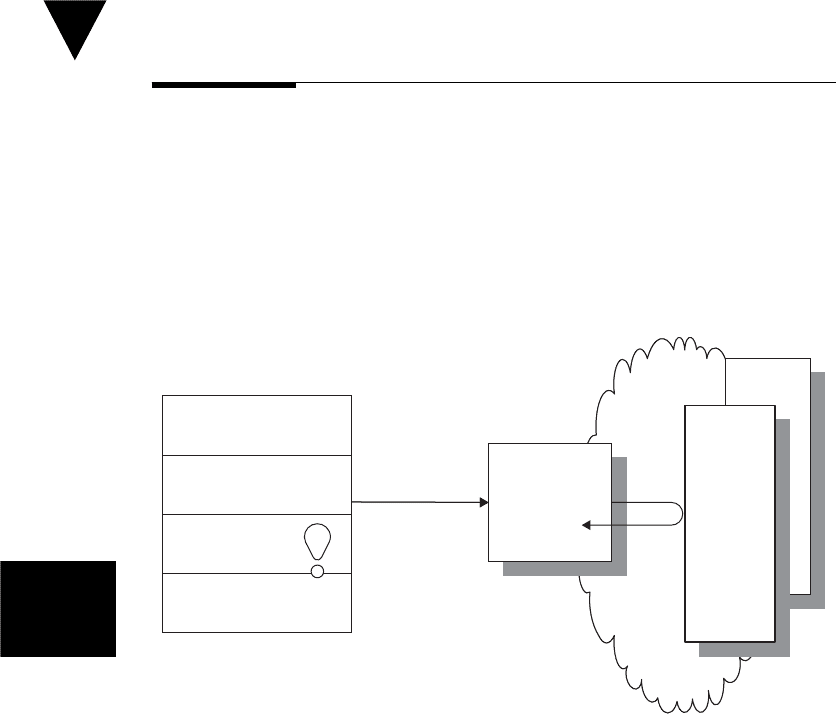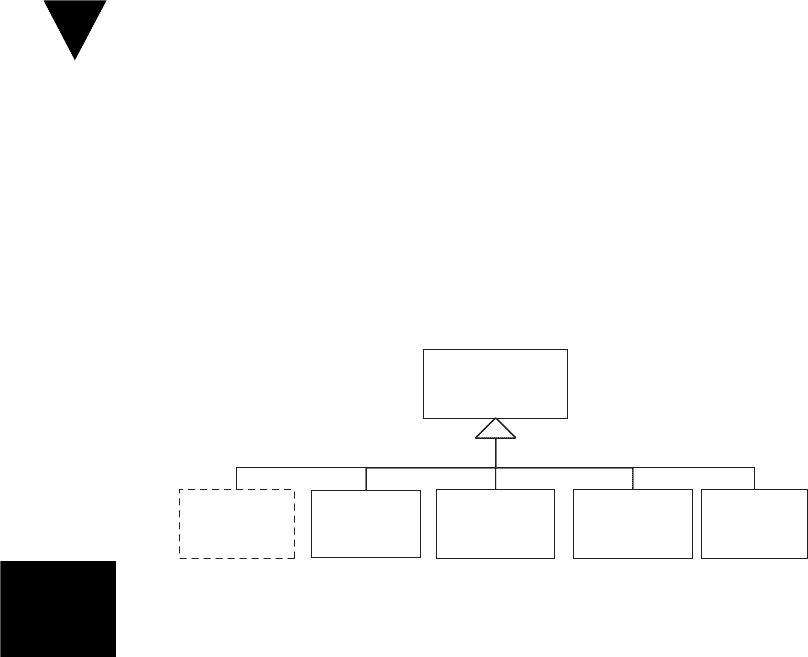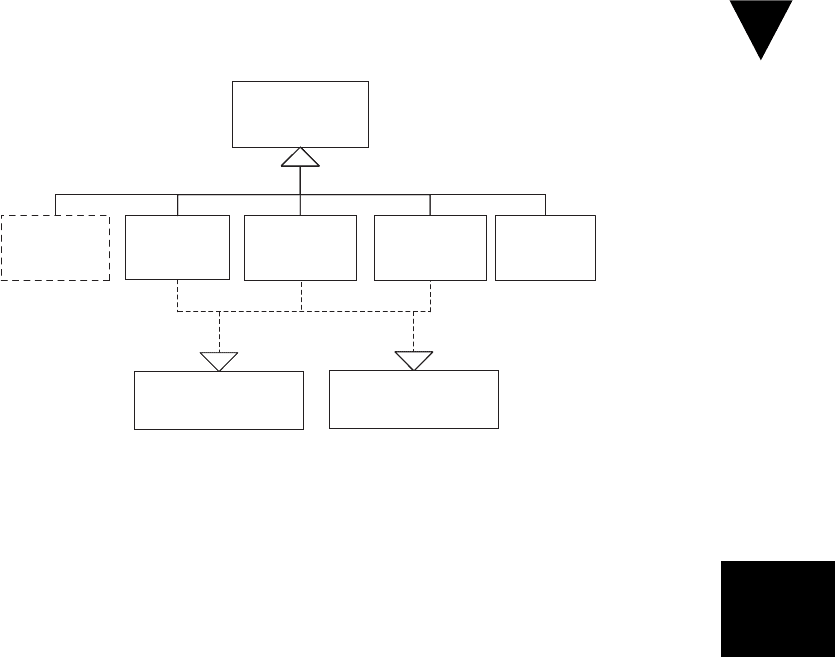Meszaros G. xUnit Test Patterns Refactoring Test Code
Подождите немного. Документ загружается.


518
Chapter 22 Fixture Teardown Patterns
to guard against the resource not being present. With this technique, a suitably
coded tearDown method can tear down various fi xture confi gurations. Contrast this
with the setUp method, which can set up only the lowest common denominator
fi xture for the Test Methods that share it.
Motivating Example
The following test creates several standard objects during fi xture setup. Because
the objects are persisted in a database, they must be cleaned up explicitly after
every test. Each test (only one of several is shown here) contains the same in-line
teardown logic to delete the objects.
public void testGetFlightsByOrigin_NoInboundFlight_SMRTD()
throws Exception {
// Fixture Setup
BigDecimal outboundAirport = createTestAirport("1OF");
BigDecimal inboundAirport = null;
FlightDto expFlightDto = null;
try {
inboundAirport = createTestAirport("1IF");
expFlightDto = createTestFlight(outboundAirport, inboundAirport);
// Exercise System
List flightsAtDestination1 =
facade.getFlightsByOriginAirport(inboundAirport);
// Verify Outcome
assertEquals(0,flightsAtDestination1.size());
} finally {
try {
facade.removeFlight(expFlightDto.getFlightNumber());
} finally {
try {
facade.removeAirport(inboundAirport);
} finally {
facade.removeAirport(outboundAirport);
}
}
}
}
There is enough Test Code Duplication (page 213) here to warrant converting
these tests to Implicit Teardown.
Refactoring Notes
First, we fi nd the most representative example of teardown in all the tests. Next,
we do an Extract Method [Fowler] refactoring on that code and call the resulting
method tearDown. Finally, we delete the teardown logic in each of the other tests.
Implicit
Teardown

519
We may need to introduce Teardown Guard Clauses around any teardown logic
that may not be needed in every test. We should also surround each teardown
attempt with a try/fi nally block to ensure that the remaining teardown logic
executes even if an earlier attempt fails.
Example: Implicit Teardown
This example shows the same tests with the teardown logic removed to the tearDown
method. Note how much smaller the tests have become.
BigDecimal outboundAirport;
BigDecimal inboundAirport;
FlightDto expFlightDto;
public void testGetFlightsByAirport_NoInboundFlights_NIT()
throws Exception {
// Fixture Setup
outboundAirport = createTestAirport("1OF");
inboundAirport = createTestAirport("1IF");
expFlightDto = createTestFlight( outboundAirport, inboundAirport);
// Exercise System
List flightsAtDestination1 =
facade.getFlightsByOriginAirport(inboundAirport);
// Verify Outcome
assertEquals(0,flightsAtDestination1.size());
}
protected void tearDown() throws Exception {
try {
facade.removeFlight( expFlightDto.getFlightNumber() );
} finally {
try {
facade.removeAirport(inboundAirport);
} finally {
facade.removeAirport(outboundAirport);
}
}
}
Note that there is no try/fi nally block around the exercising of the SUT and the
assertions. This structure helps the test reader understand that this is not an
Expected Exception Test (see Test Method). Also, we didn’t need to put a Guard
Clause [SBPP] in front of each operation because the try/fi nally block ensures
that a failure is noncatastrophic; thus there is no real harm in trying to perform
the operation. We did have to convert our fi xture holding local variables into
instance variables to allow the tearDown method to access the fi xture.
Implicit Teardown
Implicit
Teardown
This page intentionally left blank

521
Chapter 23
Test Double Patterns
Patterns in This Chapter
Test Double. . . . . . . . . . . . . . . . . . . . . . . . . . . . . . . . . . . . . . . . . . . 522
Test Double Usage
Test Stub. . . . . . . . . . . . . . . . . . . . . . . . . . . . . . . . . . . . . . . . . . . 529
Test Spy . . . . . . . . . . . . . . . . . . . . . . . . . . . . . . . . . . . . . . . . . . . 538
Mock Object . . . . . . . . . . . . . . . . . . . . . . . . . . . . . . . . . . . . . . . 544
Fake Object . . . . . . . . . . . . . . . . . . . . . . . . . . . . . . . . . . . . . . . . 551
Test Double Construction
Confi gurable Test Double . . . . . . . . . . . . . . . . . . . . . . . . . . . . . . 558
Hard-Coded Test Double . . . . . . . . . . . . . . . . . . . . . . . . . . . . . . 568
Test-Specifi c Subclass . . . . . . . . . . . . . . . . . . . . . . . . . . . . . . . . . . . 579
Test Double
Patterns

522
Chapter 23 Test Double Patterns
3
Test Double
How can we verify logic independently when code it depends
on is unusable?
How can we avoid Slow Tests?
We replace a component on which the SUT depends with a
“test-specifi c equivalent.”
Sometimes it is just plain hard to test the SUT because it depends on other
components that cannot be used in the test environment. Such a situation may
arise because those components aren’t available, because they will not return
the results needed for the test, or because executing them would have unde-
sirable side effects. In other cases, our test strategy requires us to have more
control over or visibility of the internal behavior of the SUT.
When we are writing a test in which we cannot (or choose not to) use a
real depended-on component (DOC), we can replace it with a Test Double.
The Test Double doesn’t have to behave exactly like the real DOC; it merely
has to provide the same API as the real DOC so that the SUT thinks it is the
real one!
Fixture
Setup
Exercise
Verify
Teardown
SUT
DOC
Test
Double
Fixture
Setup
Exercise
Verify
Teardown
SUT
DOC
Test
Double
Also known as:
Imposter
Test
Double

523
How It Works
When the producers of a movie want to fi lm something that is potentially risky
or dangerous for the leading actor to carry out, they hire a “stunt double” to
take the place of the actor in the scene. The stunt double is a highly trained
individual who is capable of meeting the specifi c requirements of the scene. The
stunt double may not be able to act, but he or she knows how to fall from great
heights, crash a car, or do whatever the scene calls for. How closely the stunt
double needs to resemble the actor depends on the nature of the scene. Usually,
things can be arranged such that someone who vaguely resembles the actor in
stature can take the actor’s place.
For testing purposes, we can replace the real DOC (not the SUT!) with our
equivalent of the “stunt double”: the Test Double. During the fi xture setup phase
of our Four-Phase Test (page 358), we replace the real DOC with our Test Double.
Depending on the kind of test we are executing, we may hard-code the behavior
of the Test Double or we may confi gure it during the setup phase. When the SUT
interacts with the Test Double, it won’t be aware that it isn’t talking to the real
McCoy, but we will have achieved our goal of making impossible tests possible.
Regardless of which variation of Test Double we choose to use, we must keep
in mind that we don’t need to implement the entire interface of the DOC. Instead,
we provide only the functionality needed for our particular test. We can even
build different Test Doubles for different tests that involve the same DOC.
When to Use It
We might want to use some sort of Test Double during our tests in the following
circumstances:
• If we have an Untested Requirement (see Production Bugs on page 268)
because neither the SUT nor its DOCs provide an observation point for
the SUT’s indirect output that we need to verify using Behavior Verifi -
cation (page 468)
• If we have Untested Code (see Production Bugs) and a DOC does not
provide the control point to allow us to exercise the SUT with the nec-
essary indirect inputs
• If we have Slow Tests (page 253) and we want to be able to run our
tests more quickly and hence more often
Each of these scenarios can be addressed in some way by using a Test Double.
Of course, we have to be careful when using Test Doubles because we are testing
Test Double
Test
Double

524
Chapter 23 Test Double Patterns
the SUT in a different confi guration from the one that will be used in production.
For this reason, we really should have at least one test that verifi es the SUT works
without a Test Double. We need to be careful that we don’t replace the parts of
the SUT that we are trying to verify because that practice can result in tests that
test the wrong software! Also, excessive use of Test Doubles can result in Fragile
Tests (page 239) as a result of Overspecifi ed Software.
Test Doubles come in several major fl avors, as summarized in Figure 23.1.
The implementation variations of these patterns are described in more detail in
the corresponding pattern write-ups.
Figure 23.1 Types of Test Doubles. Dummy Objects are really an alternative
to the value patterns. Test Stubs are used to verify indirect inputs; Test Spies
and Mock Objects are used to verify indirect outputs. Fake objects provide an
alternative implementation.
These variations are classifi ed based on how/why we use the Test Double. We
will deal with variations around how we build the Test Doubles in the “Imple-
mentation” section.
Variation: Test Stub
We use a Test Stub (page 529) to replace a real component on which the SUT
depends so that the test has a control point for the indirect inputs of the SUT. Its
inclusion allows the test to force the SUT down paths it might not otherwise
execute. We can further classify Test Stubs by the kind of indirect inputs they
are used to inject into the SUT. A Responder (see Test Stub) injects valid values,
while a Saboteur (see Test Stub) injects errors or exceptions.
Some people use the term “test stub” to mean a temporary implementation
that is used only until the real object or procedure becomes available. I prefer to
call this usage a Temporary Test Stub (see Test Stub) to avoid confusion.
Test
Double
Mock
Object
Test
Spy
Dummy
Object
Test
Stub
Fake
Object
Test
Double
Mock
Object
Test
Spy
Dummy
Object
Test
Stub
Fake
Object
Test
Double

525
Variation: Test Spy
We can use a more capable version of a Test Stub, the Test Spy (page 538), as
an observation point for the indirect outputs of the SUT. Like a Test Stub, a
Test Spy may need to provide values to the SUT in response to method calls.
The Test Spy, however, also captures the indirect outputs of the SUT as it is
exercised and saves them for later verifi cation by the test. Thus, in many ways,
the Test Spy is “just a” Test Stub with some recording capability. While a Test
Spy is used for the same fundamental purpose as a Mock Object (page 544),
the style of test we write using a Test Spy looks much more like a test written
with a Test Stub.
Variation: Mock Object
We can use a Mock Object as an observation point to verify the indirect outputs
of the SUT as it is exercised. Typically, the Mock Object also includes the func-
tionality of a Test Stub in that it must return values to the SUT if it hasn’t already
failed the tests but the emphasis
1
is on the verifi cation of the indirect outputs.
Therefore, a Mock Object is a lot more than just a Test Stub plus assertions: It
is used in a fundamentally different way.
Variation: Fake Object
We use a Fake Object (page 551) to replace the functionality of a real DOC
in a test for reasons other than verifi cation of indirect inputs and outputs of
the SUT. Typically, a Fake Object implements the same functionality as the
real DOC but in a much simpler way. While a Fake Object is typically built
specifi cally for testing, the test does not use it as either a control point or an
observation point.
The most common reason for using a Fake Object is that the real DOC
is not available yet, is too slow, or cannot be used in the test environment
because of deleterious side effects. The sidebar “Faster Tests Without Shared
Fixtures” (page 319) describes how we encapsulated all database access behind
a persistence layer interface and then replaced the database with in-memory
hash tables and made our tests run 50 times faster. Chapter 6, Test Automation
Strategy, and Chapter 11, Using Test Doubles, provide an overview of the vari-
ous techniques available for making our SUT easier to test.
1
My mother grew up in Hungary and has retained a part of her Hungarian accent—think
Zsa Zsa Gabor—all her life. She says, “It is important to put the emphasis on the right
syllable.”
Test
Double
Test Double

526
Chapter 23 Test Double Patterns
Variation: Dummy Object
Some method signatures of the SUT may require objects as parameters. If
neither the test nor the SUT cares about these objects, we may choose to pass
in a Dummy Object (page 728), which may be as simple as a null object ref-
erence, an instance of the Object class, or an instance of a Pseudo-Object (see
Hard-Coded Test Double on page 568). In this sense, a Dummy Object isn’t
really a Test Double per se but rather an alternative to the value patterns Literal
Value (page 714), Derived Value (page 718), and Generated Value (page 723).
Variation: Procedural Test Stub
A Test Double implemented in a procedural programming language is often
called a “test stub,” but I prefer to call it a Procedural Test Stub (see Test Stub)
to distinguish this usage from the modern Test Stub variation of Test Doubles.
Typically, we use a Procedural Test Stub to allow testing/debugging to proceed
while waiting for other code to become available. It is rare for these objects to
be “swapped in” at runtime but sometimes we make the code conditional on a
“Debugging” fl ag—a form of Test Logic in Production (page 217).
Implementation Notes
Several considerations must be taken into account when we are building the Test
Double (Figure 23.2):
• Whether the Test Double should be specifi c to a single test or reusable
across many tests
• Whether the Test Double should exist in code or be generated on-the-fl y
• How we tell the SUT to use the Test Double (installation)
The fi rst and last points are addressed here. The discussion of Test Double gen-
eration is left to the section on Confi gurable Test Doubles.
Because the techniques for building Test Doubles are pretty much independent
of their behavior (e.g., they apply to both Test Stubs and Mock Objects), I’ve
chosen to split out the descriptions of the various ways we can build Hard-Coded
Test Doubles and Confi gurable Test Doubles (page 558) into separate patterns.
Test
Double

527
Figure 23.2 Types of Test Doubles with implementation choices. Only Test
Stubs, Test Spies, and Mock Objects need to be hard-coded or confi gured by the
test. Dummy Objects have no implementation; Fake Objects are installed but
not controlled by the test.
Variation: Unconfi gurable Test Doubles
Neither Dummy Objects nor Fake Objects need to be confi gured, each for their
own reason. Dummies should never be used by the receiver so they need no
“real” implementation. Fake Objects, by contrast, need a “real” implementa-
tion but one that is much simpler or “lighter” than the object that they replace.
Therefore, neither the test nor the test automater will need to confi gure “canned”
responses or expectations; we just install the Test Double and let the SUT use it
as if it were real.
Variation: Hard-Coded Test Double
When we plan to use a specifi c Test Double in only a single test, it is often sim-
plest to just hard-code the Test Double to return specifi c values (for Test Stubs)
or expect specifi c method calls (Mock Objects). Hard-Coded Test Doubles are
typically hand-built by the test automater. They come in several forms, including
the Self Shunt (see Hard-Coded Test Double), where the Testcase Class (page 373)
acts as the Test Double; the Anonymous Inner Test Double (see Hard-Coded Test
Double), where language features are used to create the Test Double inside the
Test Method (page 348); and the Test Double implemented as separate Test
Double Class (see Hard-Coded Test Double). Each of these options is discussed
in more detail in Hard-Coded Test Double.
Configurable
Test Double
Test
Double
Mock
Object
Test
Spy
Dummy
Object
Test
Stub
Fake
Object
Hard-Coded
Test Double
Configurable
Test Double
Test
Double
Mock
Object
Test
Spy
Dummy
Object
Test
Stub
Fake
Object
Hard-Coded
Test Double
Test Double
Test
Double
